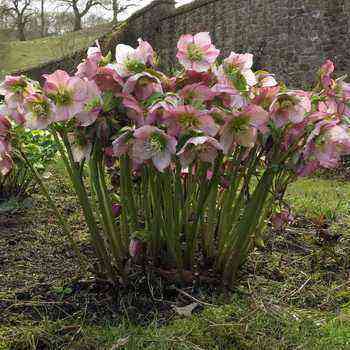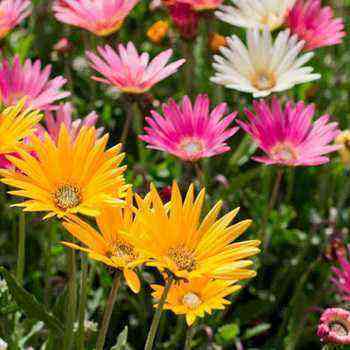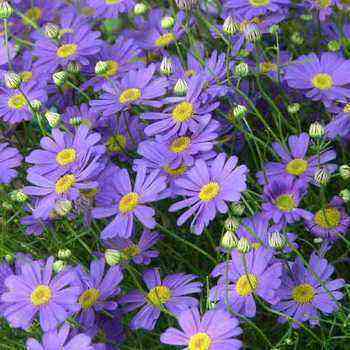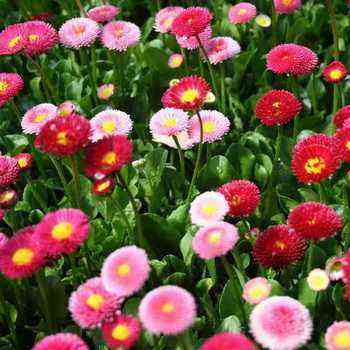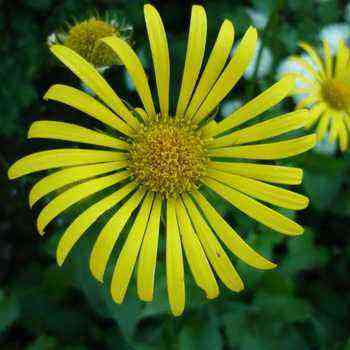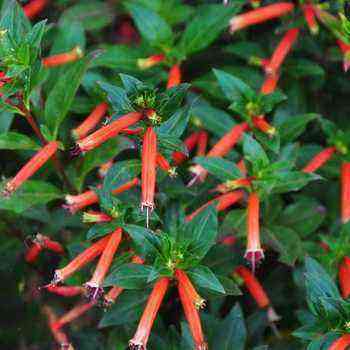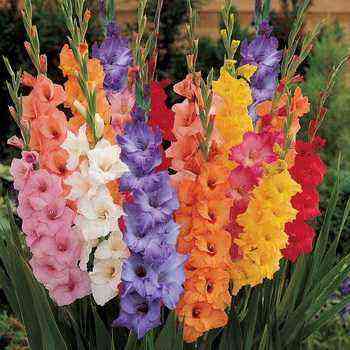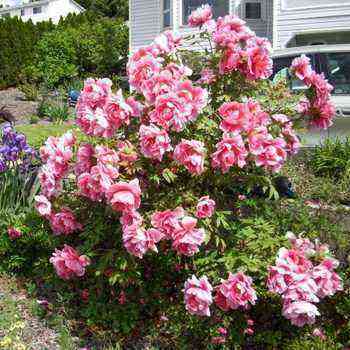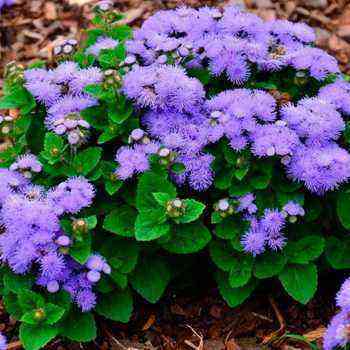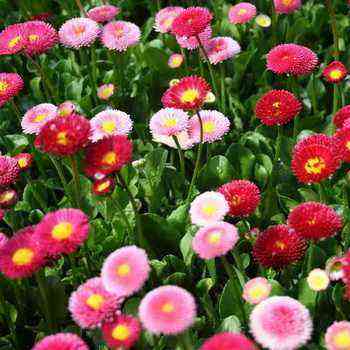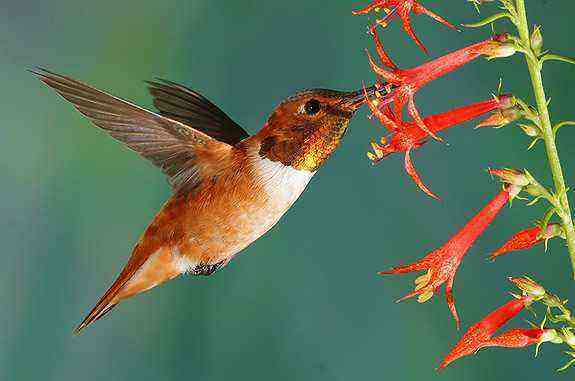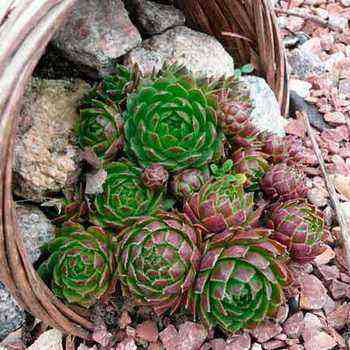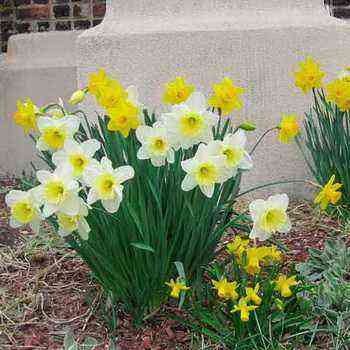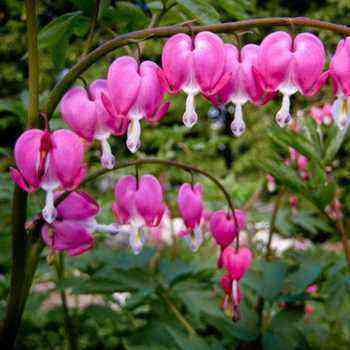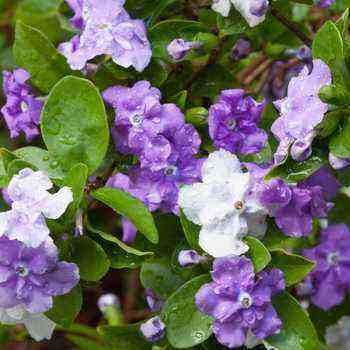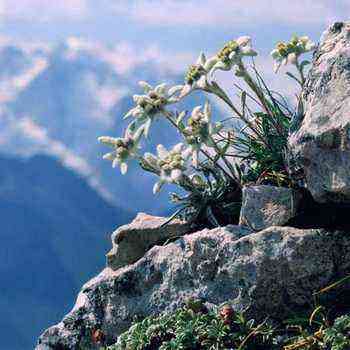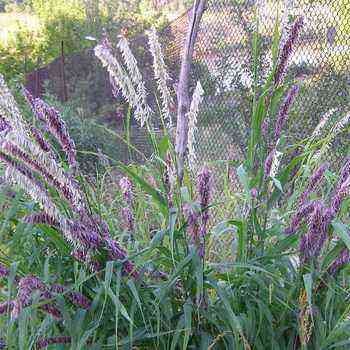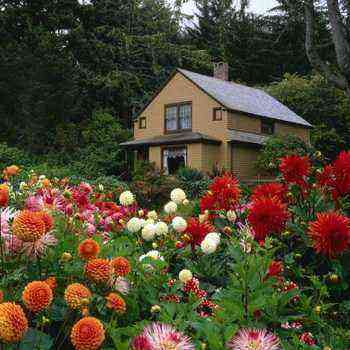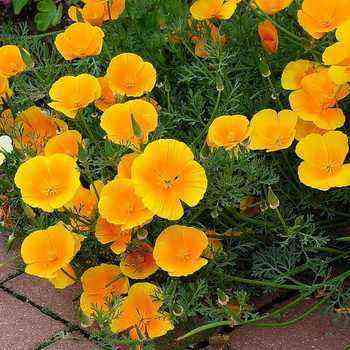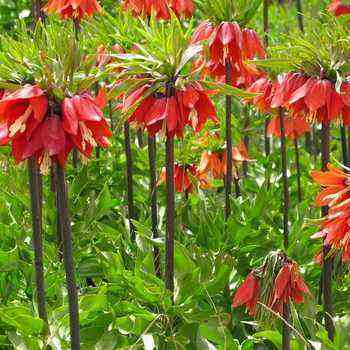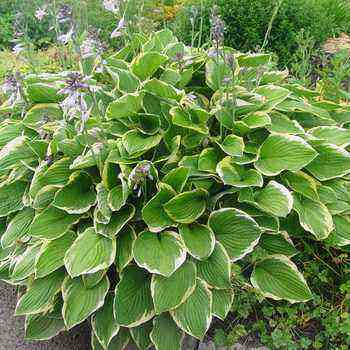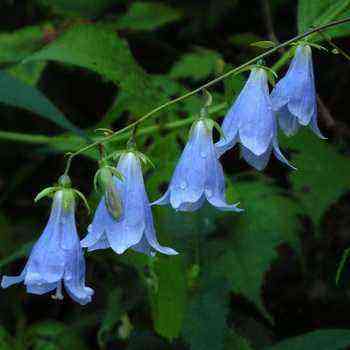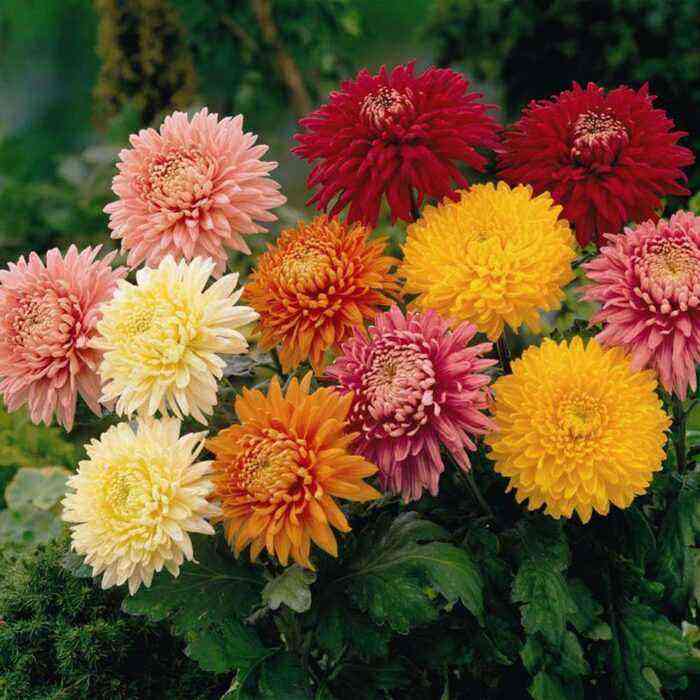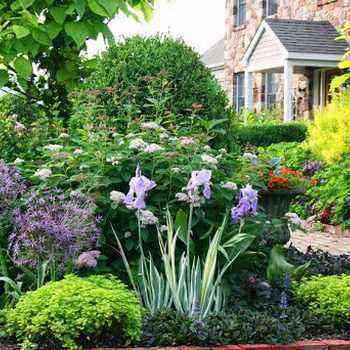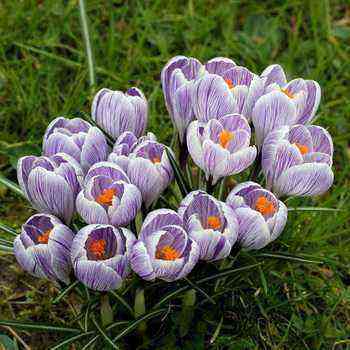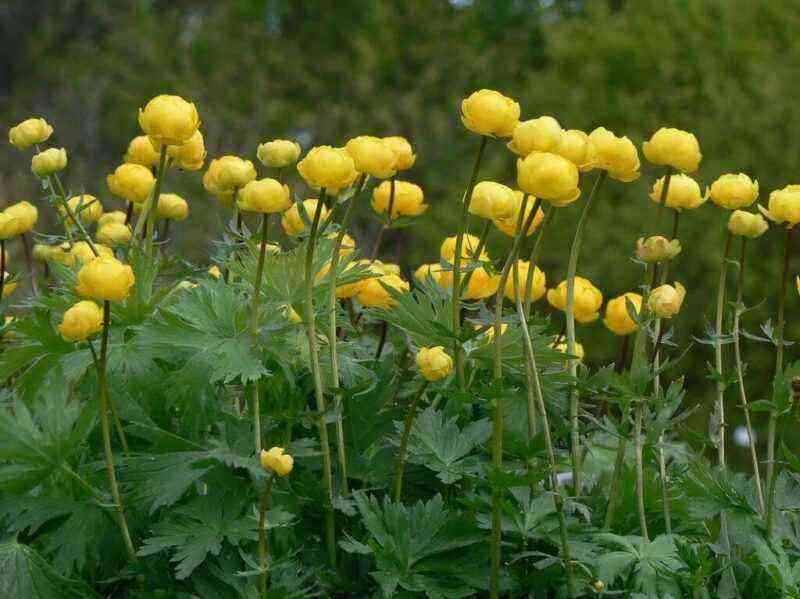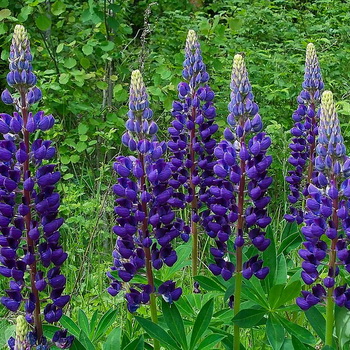 Not all gardeners appreciate lupine plants and in vain, because these tall flowers with bright long inflorescences in skillful hands become a spectacular decoration of flower beds. This culture is universal, since it is combined with many other ornamental plants, looks beautiful in single plantings and helps to create interesting and unusual compositions in the garden. Fortunately, there are many types and varieties of this simple, but in its own way attractive flower in the world. In addition, lupine is used as green manure, fodder crops and medicinal raw materials.
Not all gardeners appreciate lupine plants and in vain, because these tall flowers with bright long inflorescences in skillful hands become a spectacular decoration of flower beds. This culture is universal, since it is combined with many other ornamental plants, looks beautiful in single plantings and helps to create interesting and unusual compositions in the garden. Fortunately, there are many types and varieties of this simple, but in its own way attractive flower in the world. In addition, lupine is used as green manure, fodder crops and medicinal raw materials.
The article will discuss how lupine looks like, what its varieties are, and also gives tips on how to breed this plant on the site and how it can be applied.
Homeland – Mediterranean, North America.
The plant got its name from the Latin word “lupus” – wolf, hence the wolf “beans”, in contrast to real beans, for the presence of bitter, poisonous substances in the seeds. Perennial lupine was introduced to Europe from North America at the beginning of the 20th century.
What a lupine flower looks like: characteristics (with photo)
This flower is extremely interesting because, depending on the comfort of the environment, it can live as an annual, biennial or perennial. In central Russia, perennial species are most often grown.


According to the botanical description, lupine has a powerful taproot and herbaceous, leafy stems. The plant has palmate-separated complex leaves on long petioles and a flower raceme with beautiful flowers. Some varieties have a flower cluster up to 1 m long, while others, on the contrary, have many short and wide inflorescences. The color of the flowers is from white and yellow to pink, red and purple. There are two-color varieties of lupins, they have an excellent combination of different colors: white with blue, blue with yellow, orange with bright red.
They bloom in June – July for a long time and luxuriously. Fading flower stalks should be cut at the very root, without leaving hemp, as they are hollow and water entering them can cause decay of the rhizome. If the plant is not allowed to inseminate, then it will bloom again in August.
After cutting off the flowering stems, the plants form new shoots, which can prolong flowering until late autumn. Lupine develops well and blooms for 3-4 years, after which it is recommended to replace old plants with young seedlings.
Characteristic features of lupine
Lupine has its own characteristics that distinguish it from many other garden flowers.
As noted above, it got its name in honor of the wolf for its resistance to any conditions, and the only minus of the plant is again in its endurance. Even as an annual, in just 1 season, its bush manages to grow to incredible sizes, lose its shape and even clog the flowers that are within reach, so lupins need to be trimmed or pulled in time. It should also be remembered that only flowers of 1 shade should be planted next to each other, otherwise the plant will become pollinated in a fairly short period of time and, having mixed the shades of the inflorescences, will lose its attractive appearance. The unpretentiousness of the plant is the main advantage in describing the lupine plant, in this it will be practically out of competition, since its ability to live even on the most scanty soil is simply amazing.
Plants, on which blue inflorescences appear from time to time, should be removed, because the wild blue lupine is the ancestor of all multi-colored hybrids and, pollinating cultivated varieties, it will certainly take over in the offspring, and therefore in the future all varietal lupins will gradually run wild.
The names of popular species and varieties of lupine (with photo)
In total, there are at least 200 species of lupine in the world, among which perennials are the most popular in Russia.
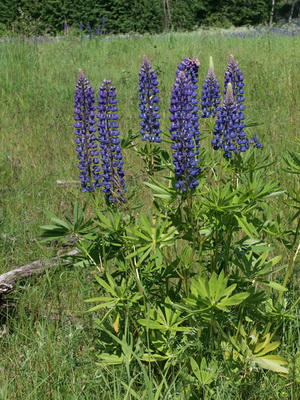
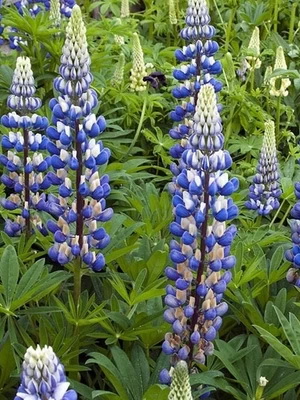
Lupine multifoliate (Lupinus Polyphyllus Lindl.)
In the United States, this species is called large-leaved lupine.
Found in the western and northwestern regions of North America. Grows on river banks, meadows and roadsides and other disturbed habitats. Naturalized in Russia and is found in the taiga zone of the European part.
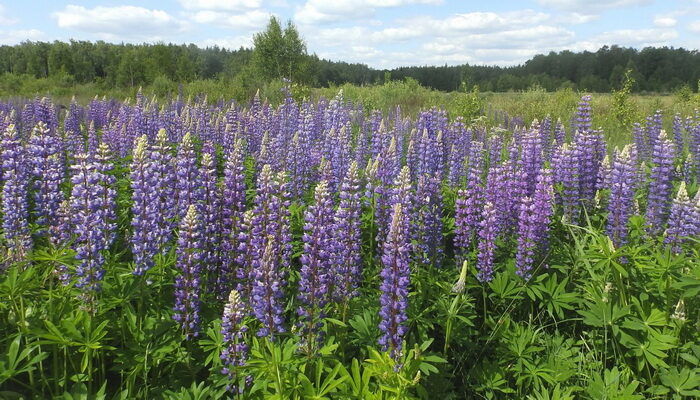
Anyone who grows this species on the site knows firsthand what a multi-leaved lupine flower looks like.
It is a short-lived perennial or biennial herb up to 1.5 m high. The leaves are palmate, on long petioles, with 9–15 narrow-lanceolate leaves. The stem and leaf petioles are covered with sparse, short hairs. The calyx and young leaves have silvery pubescence. The flowers are blue, less often pink and white, collected in multi-flowered apical erect inflorescences up to 35 cm long. The fruit is a pubescent bean. Seeds are oval, flattened, almost black.
Varieties of multifoliate lupine are distinguished by a rich color range, for this reason they can be seen quite often in flower beds.
Varieties of multifoliate lupine:

“Schloss Frau” – light pink flowers;
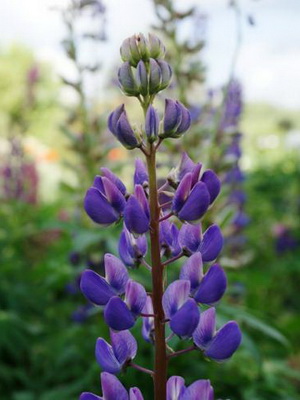
“Castellane” – blue or purple flowers;

“Albus” – a variety with snow-white inflorescences;

“Abendglut” – purple-red flowers;

“Burg Fraulen” – cream-colored inflorescences;
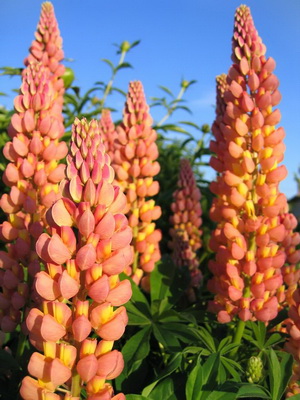
“Apricot” – bright orange flowers;

“Carmineus” – red flowers;

“Princess Juliana” – white and pink inflorescences

“Kronloichter” – rich yellow inflorescences;
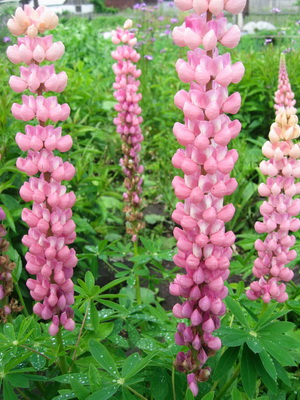
“Roseus” – pink inflorescences.
Russell’s hybrids, bred in England almost a hundred years ago, are still relevant. They are very different from ordinary lupins in their more beautiful and varied color, size of flowers and peduncles, long flowering. Mixed varieties are usually commercially available.
All the brightness and variety of varieties of multifoliate lupine are shown in the photo selection below:
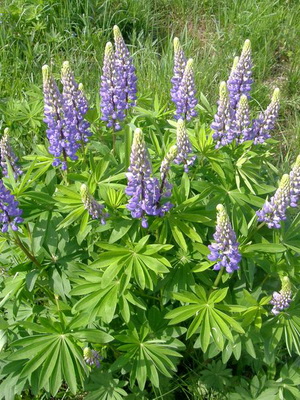
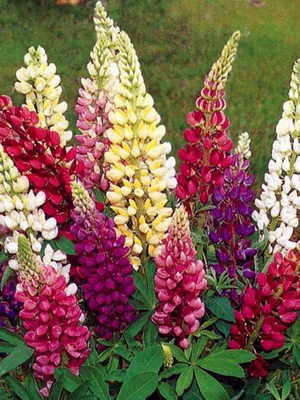


Lupine tree (lupinus arborescens).
Perennial plant up to 1.5 m in height with five-leafed leaves pubescent on the underside and yellow or white flowers, collected in thin straight inflorescences.

Perennial lupine (lupinus perennis) is a plant up to 60 cm high with dark pink flowers.


White lupine (lupinus albus).
Answering the question, what are the lupines, one cannot fail to mention the white annual, which is one of the most popular species.
It has such a powerful root system that it is able to strengthen a crawling sandy slope, it blooms for a long time and brightly. Reaches up to 2 m in height. The leaves are obovate, oblong, smooth above, slightly pubescent below. Inflorescences are long, reaching about 30 cm. In the upper part, the flowers are whorled, alternate below. The fruit is a pod, pubescent at first, becomes smooth as it ripens. The fruit contains 3 to 6 seeds inside. Seeds are square, smooth, white.
White lupine varieties:

“Noble Girl” is a favorite unpretentious, spectacularly blooming perennial. The leaves are very beautiful, the flowers are pure white, collected in inflorescences up to 35-40 cm long. Plant height – up to 100 cm. Very decorative in single and group plantings;
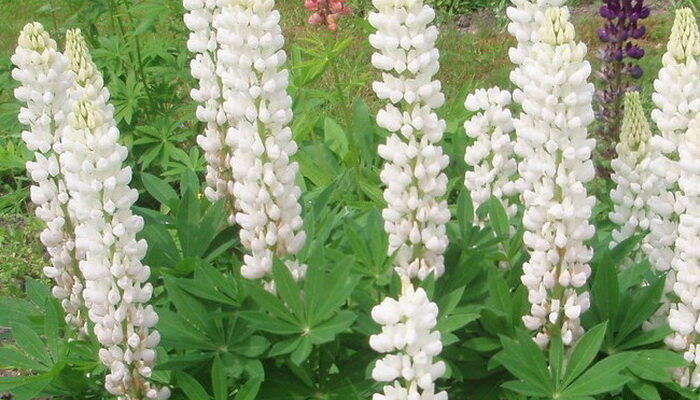
“Desnyanskiy” – up to 120 cm high. It has white seeds inside. Mainly used as a forage crop;

“Gamma” – grows up to 80 cm in height.
The description of the white lupine flower is supplemented with a photo, in which you can see what are the distinctive features of this species:
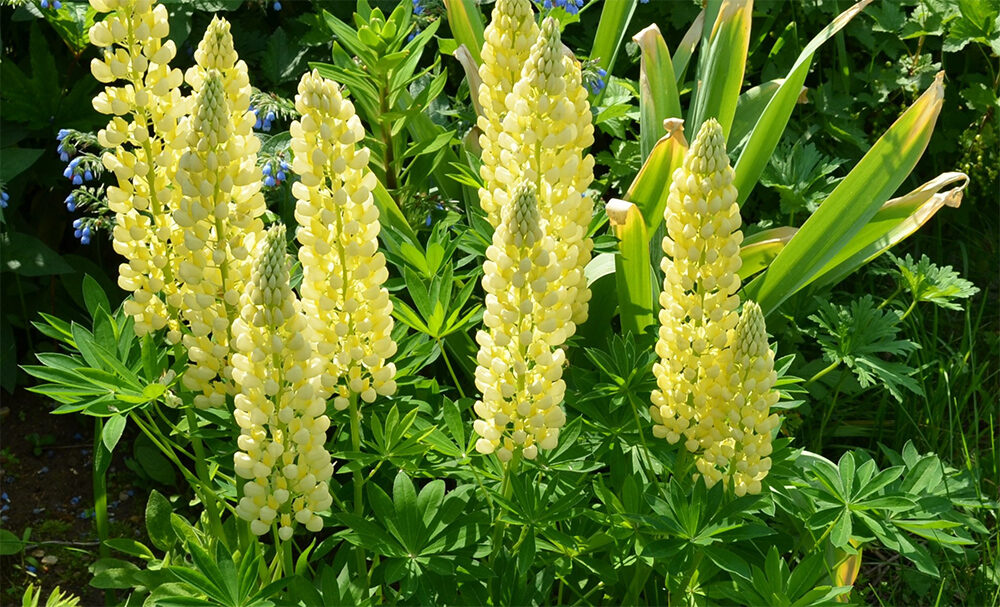
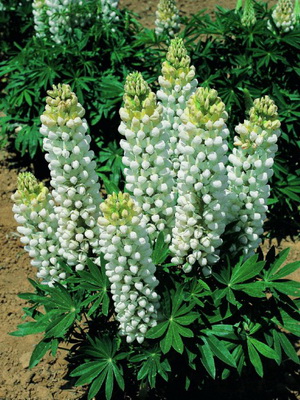
Lupine yellow (Lupinus luteus).
Annual about 1 m high. The leaf plates are finger-shaped. There is slight pubescence on their surface. The inflorescence is an ear of orange or bright yellow hue. The fruit is a flat bean with 5 seeds.
It adapts easily to sandy soil, and is also used for pet food due to the high protein content of the beans.
There are many other decorative types of lupins, as evidenced by the selection of photos below:
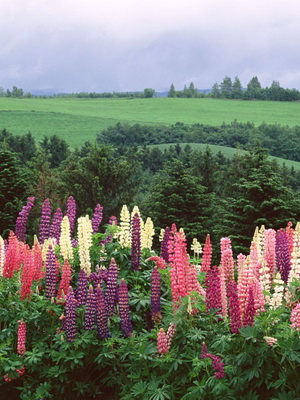


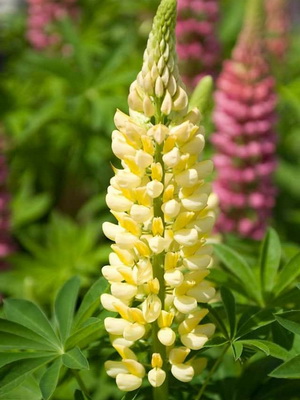
What are the decorative varieties of lupine
Decorative varieties of lupine are designed to decorate a flower garden, ennoble the site and create beautiful garden compositions. Unlike forage varieties, they look brighter and more impressive.
Below are the names of those varieties of lupine and their photos, which are most often grown in flower beds and serve as a real decoration of the garden plot.
Hybrid varieties are distinguished by the height and density of the inflorescence, which opens to the very top, as well as a variety of bright colors.
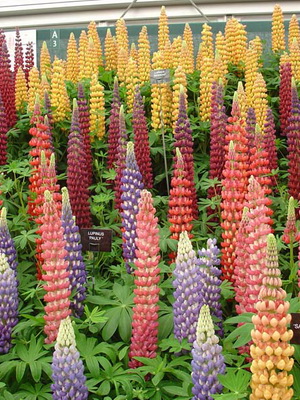



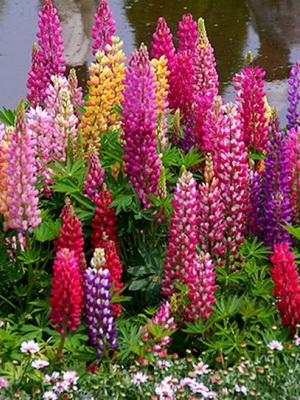
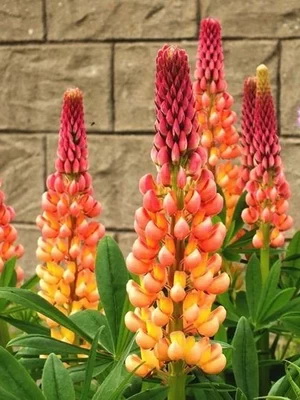
There are very beautiful varieties of raspberry color “Carmineus”, “Countess”, various pink ones, for example, “Roseus”, “Albus”, “Geyser”, “White Knight” – white, “Candlestick” – yellow, “Rubinkenig” – ruby purple.

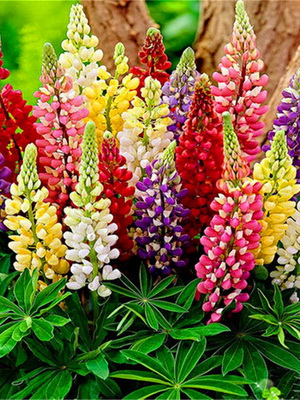
Lupine “Fireworks” , a mixture of colors. Favorite showy flowers of many gardeners. The plant is 100–120 cm high. The leaves are beautiful, palmate-compound, on long petioles. Racemose inflorescences of red, white and yellow. Abundant flowering in June. Used for curbs, ridges, mixborders.
The photo above will help you find out what the Fireworks lupine looks like, which proves how beautiful this variety is.


Lulu Russell variety. New, miniature lupins up to 50 cm high, beautiful leaves. Flowers are collected in racemose inflorescences of different colors: white, yellow, blue, pink, red. Blooms in June, July. Very good for curbs, discounts.


Variety “Minaret” – a low bush, reaching 50 cm, 30 cm of which is the length of the plant brush. The flowers are tightly pressed against each other.
There are interesting bicolor varieties. But the most incredible colors appear from seeds when hybrid lupins are cross-pollinated with each other.
To understand how lupine looks in the garden, you can take a look at the photo below and make sure that this plant is able to transform and revitalize even a modest area:
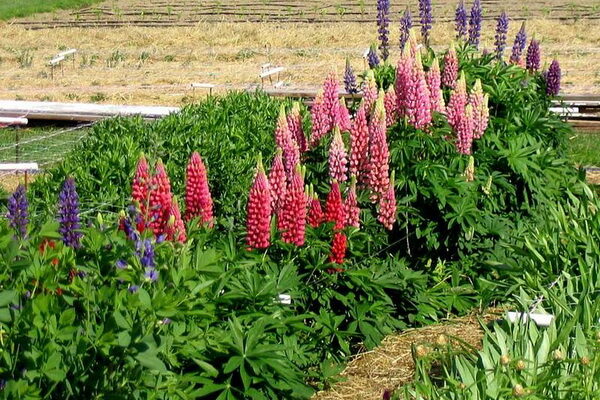
Conditions for growing lupine on the site
Lupine is not picky about growing conditions, however, there is a certain agricultural technique for its breeding, which is recommended to be followed in order to get good results.
Location. Lupine is photophilous, but it also grows in partial shade. It is desirable that suitable predecessors – winter and spring crops – grow on the selected site up to lupine. It is not recommended to plant it after leguminous plants, there is a high probability of being damaged by diseases and pests.
If lupine flowers are grown in a place not protected from the winds, it is better to tie them to a support, since they have a thin stem. Strong gusts of wind can break the plant. For support, an ordinary wooden pole or a thin, but strong branch is suitable.
The soil. It prefers loose, well-drained, nutritious soils with a neutral or slightly acidic reaction. On acidic soils, lupine does not bloom, and the foliage loses its brightness. On the areas where lupins grow, lime is added every 2 to 3 years.
On alkaline soils, the likelihood of developing diseases of this culture is high. If this is the soil in the garden, it is necessary to water the area with a weak acid solution or add peat before planting lupine flowers.
How to properly care for lupines
Watering. Watering is important for the normal growth and development of this crop, so this work must be done correctly. In hot dry weather, the volume of irrigation is increased, on cloudy days, it is reduced. It is best to water the flower as the soil dries up.
After watering, the soil around the bush is loosened, weeds are removed. When caring for lupine, periodically soil is poured under the bush so that the root collar is always closed from winds and drafts.
Hilling and support. Due to the fact that in old specimens, the root collar rises several centimeters above the soil surface, the middle part of the bush gradually dies off, and the side rosettes are isolated. Therefore, to preserve decorativeness and prolong life, the plants are spud. Tall plants located in open wind-blown areas must be tied to a support.
Top dressing. In the second year, lupins are fed before flowering: for 10 liters of water, dilute 1 tbsp. spoon of potassium sulfate, superphosphate and “Intermag” for flowers and ornamental crops, spending 3 liters per bush. During the beginning of flowering, wood ash is poured in 2-3 tbsp. spoons under the bush.
Care after flowering. Gardeners engaged in the cultivation of this culture are interested in the question of how to care for lupines after flowering. After flowering, the peduncles must be removed, since secondary flowering is possible under favorable weather conditions. In the autumn, the bushes are spudded to close the bare root collar, sprinkle the soil around the plant with a layer of mulch.
If the grower needs to collect the seeds of a given crop, this can also be done after flowering, since the beans will have formed on the plant by that time. When ripe, they crack, the seeds are scattered on the ground. In order not to lose the seeds, the gardener needs to tie in advance the beans that have not yet begun to crack with gauze, where they will remain when the fruits crack.
Wintering. When caring for lupine when growing it, it should be borne in mind that, despite the fact that this plant tolerates winter well, some work needs to be done to prepare it before the onset of the cold season.
When preparing lupine for the winter period, the faded buds are cut off, the yellowed dry leaves are removed. If the culture is grown in regions with frosty winters, it is covered with a layer of peat for the winter. All fallen leaves are removed under the bush in order to avoid the development of diseases and the invasion of possible pests.
Diseases and pests. Of the diseases, lupine affects powdery mildew in a rainy, cold summer, and sometimes this culture gets sick with a viral disease – mosaic. Such a plant should be destroyed along with the roots and a clod of earth. And against powdery mildew, you can use Fitsporin or do nothing at all. Usually powdery mildew appears after flowering, at the end of summer, and therefore you can simply cut the plant at the soil level without leaving hemp. Usually, the leaves and stems are not harvested at all.
Propagation of lupine by cuttings or side rosettes
Propagated by seed and vegetatively (lateral rosettes and cuttings). Annual species can be propagated only with the help of seeds, and perennial species in both ways.
In order to guarantee the preservation of the color of the specimens you like, propagation of lupine by cuttings is carried out. It is best to propagate with lateral rosettes produced by mature but not old plants. Basal rosettes are cut into cuttings in spring, which develop from the buds at the base of the stem; and in summer, lateral shoots that form in the leaf axils.
In the area where the cuttings will be planted, sand should be added to the soil, this will make it lighter. The planting material is placed in the ground, where it will adapt and take root within 1 – 1.5 months. After this time, the mature and rooted seedlings can be transplanted to a permanent place, for example, in a flower garden or flower bed.
It is advisable not to keep the plant longer than the specified period, since it will have time to take root and take root deep into the soil. The lupine root system is quite vulnerable and reacts painfully to any interference. In this case, the transplant will be tolerated by the plant rather painfully.
After planting lupines, regular maintenance is necessary, consisting of watering, loosening and removing weeds.
Lupine propagation by seeds in autumn and spring
In order to increase the germination of seeds, they are stratified. To do this, the seeds are placed in cheesecloth and put into the freezer. After removing from the freezer, immediately place it in very hot water for no more than 1 minute. This method will crack the bean shell and achieve the desired effect.
Another way of stratification can be used. Soak the seeds for 10 hours in a solution of bleach or 15 minutes in potassium permanganate. For 1 glass of water, take 2 drops of bleach (10%). After the specified time, place the seeds in clean cool water and hold for another 10 minutes. This method of stratification is the prevention of plant damage by fungi or diseases.
When propagating by seeds of frost-resistant species of lupine, it is better to sow them before winter in late October – early November, after the first frost – then the plants bloom in August next year. The seeding depth is 1.5–2.5 cm. After seeding, the seeds are sprinkled with a thin layer of earth or peat. The distance between the holes should be at least 15 cm. In spring, when the snow melts and the weather is warm, the gardener will already be able to see lupine sprouts, and at the end of summer it will bloom.
Seeds are sown directly into the ground and in the spring, as soon as the snow melts. Plants bloom the next year in early May.
Recommendations for growing lupine seedlings from seeds
Many gardeners grow lupine seedlings from seeds, while following simple recommendations.
After stratification, you can sow seeds for seedlings using small containers such as peat pots, plastic cups or compact containers. Each container should have drainage holes.
The soil for planting seedlings should consist of clean river sand, peat and turf. The main condition for the soil is its lightness.
The prepared soil mixture should be poured into a container, tamped slightly, sprinkled with water at room temperature, put the seeds on top, deepen them a little and water again. After that, cover the containers with foil or glass and remove to a warm, bright place.
Care for the sowing of a lupine flower after planting will consist in periodic watering (as the earthen coma dries up). The first shoots will appear in 10 – 14 days. Seedling care includes regular watering and ventilation of young growth. The film must be removed for several hours a day. When the plants are fully grown, the polyethylene can be removed altogether.
Planting lupine seedlings in open ground and caring for it should be carried out only when stable warm weather is established and night frosts disappear. At that time, the seedlings should have 5 – 6 leaves.
When planting, the distance between the plants should be about 40 cm. Plant the seedlings in loose, well-moistened soil. This work should be done carefully, trying not to damage the root system.
How lupine is used in the garden (with photo)
Decorative types and varieties of lupine are widely used in the garden. During the flowering period, this uncomplicated flower looks just great. Its variegated lush inflorescences enliven the garden and give it a special flavor. Openwork rich green foliage adds even more expressiveness to tall lupine.

Lupines in the garden can be planted in groups on the lawn, in the meadows or together with other plants (distance between plants – 40 cm). Irises, lilies, delphiniums and phlox go well with lupins.
This crop is recommended to be placed in the background or middle ground of mixborders or rabatoks, in flower beds, as individual plants or in whole groups, along the boundaries of the site. The planting pattern is 70 × 70 cm. It can be cut into bouquets, but it does not stand in the water for long, no more than a week.
In many countries, lupine is planted as a “green manure” (catch crop) in cultivated fields and used as forage. The soil where it grows is enriched with nitrogen and can be used by other plants.
The alkaloid lupine, which is found in all organs of lupine, is harmful to sheep and cattle. Some tribes of North American Indians feed the plant to horses for medicinal purposes.
Lupine instead of dung
This plant is a natural soil fertilizer.
“Cut lupine bushes have the power of the best manure. I believe that if the owner has nothing, then the lupine will always come to the rescue. If it is scattered on bad soil and plowed around the September ida, and then cut off in time with a plow or a hoe, then it will reveal the properties of the most excellent fertilizer, ”wrote the Roman writer Columella in the 1st century.
Another Roman scientist, Pliny, who also lived in the 1st century, in his “Natural History”, consisting of 37 books, devotes enthusiastic lines to lupine:
“There is not a single plant that, by its very nature, feels the sun and the earth more amazingly. First, he makes a daily cycle with the sun and even with a cloudy sky shows the farmer what time it is. In addition, he blooms three times … And only he is sown on an unplowed field … Does not require care at all … We have already said that sowing it improves soils and vineyards, and therefore he himself does not need manure so much that he himself can replace the best manure”.
Lupine chernozem
Lupine has a powerful root system that perfectly loosens the soil. In addition, nodule bacteria live on its roots, transferring nitrogen from the air to soil nitrogen, which is well absorbed by plants. So, like all legumes, it enriches the soil with nitrogen, thereby improving its fertility. This cold-resistant plant can be sown at the end of April, and in the southern regions in early spring, as soon as the soil thaws. Annual species quickly gain a large green mass, as they bloom in June. But they do not need to bloom, so that they do not spend the supply of nutrients for the formation of buds and flowers. At the moment the peduncle extends, it must be dug up along with all the green mass and roots to the depth of the shovel bayonet. Nodule bacteria will live for a long time on the remnants of roots and continue to store nitrogen in the soil, and the biomass of the green part of lupine will enrich the soil with nutrients and at the same time serve as a good loosening agent for dense soil. Immediately after digging, it is necessary to sow the seeds of the plant again, which in a warm autumn will have time to grow to the stage of buds. At this time, you need to dig it up again, or let it overwinter if you have sown perennial lupine. After three consecutive sowings of lupine, followed by digging, even the clay soil becomes black earth.
